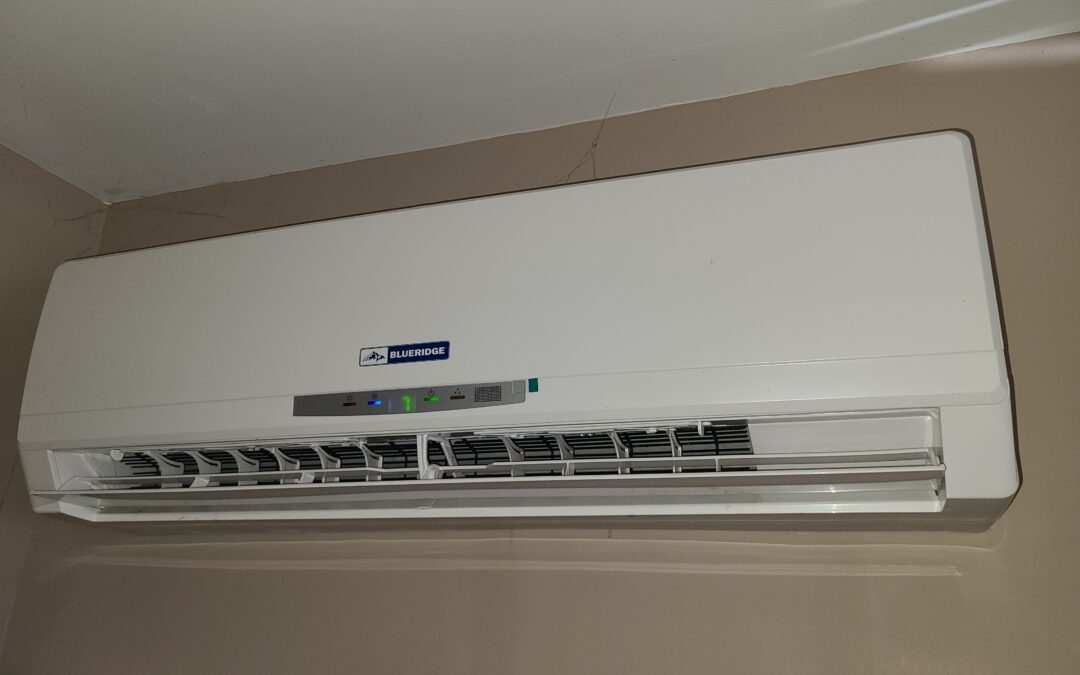
by blogediter | Jun 27, 2023 | Save Energy
With record high energy rates this year, it is even more important to save on home cooling costs. See how to save energy on air conditioner in summer.
Investing in long-term solutions for saving on home cooling can save you money in the long run. Here are some little-known unusual home improvements to save on home cooling costs:
- Use Mini Splits for HVAC when possible: Everyone wants to know the cheapest way to cool a house. If you have a home that is less than 1000 square feet and you live in a climate that rarely gets below 20 degrees F, you should really consider a mini split system to save on home cooling. They use much less wattage than a traditional central A/C system, and they move and cool air much more efficiently.
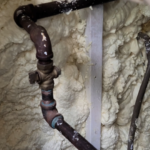
Closed cell foam to save on cooling
- Air Seal BEFORE you insulate: If you don’t air seal first and then insulate second, then outside air will pass right through your insulation. That is the nice thing about the Flueblocker, it will air seal and insulate your fireplace chimney in one shot and save on home cooling. That is why it is so good at sealing out chimney odors as well. Air Sealing is important in your attic especially. You should peel back your attic insulation and look at the drywall on top of electrical boxes and wall caps, as well as any pipe, HVAC, or electrical penetrations in the drywall. All of those spots should be caulked or foamed before the insulation is laid over them. If you see dirty black areas in your insulation near these penetrations, then that tells you your air sealing is insufficient.
- Programmable Thermostats: Using a programmable thermostat can save on home cooling costs in the long run. By setting your AC as high as is comfortably possible and using a programmable thermostat to increase temperature when you’re out, or asleep, could easily decrease your summer cooling bill by 10%.Some people wonder: “Does setting AC higher save money?” and “What is the best temperature for AC to save money?” The best AC setting to save money is to set your thermostat to 78ºF instead of 72ºF, and use ceiling fans to move the air to make it feel 7ºF cooler. You can cut as much as 18% off your summer cooling costs.
-
Consider attic ventilation: There are many kinds of attic fans, but I am going to speak about gable fans in particular to save on home cooling. If you have HVAC vents and air handlers in your attic, this is a very important topic to save on home cooling. Look to see if you have the 3 kinds of attic venting, they are gable vents, ridge vents and soffit vents.
If you have all 3, then you may want to have an adjustable speed gable vent installed. on cool days the fan does not turn on, but on hot days it will draw in outside air to keep your attic cooler and save on home cooling.
-
Lighter colored shingles or metal roofing: If you are looking to replace your roof soon, consider light grey colored shingle to save on cooling costs in the summer. These are called
Cool Roof systems, and they come in many different kinds of roofing material from asphalt, to metal, to tile, etc…
Just like wearing light colored clothes makes you feel cooler on a hot day, Cool Roofs limit the amount of radiant heat a roof surface transmits through to the attic space.
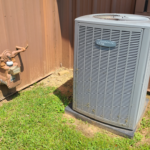
Save on home cooling shade your AC Condenser
You may ask: “How can I save on cooling my house?” Some are as easy as shading your AC condenser outside. Or in the spring selecting the best time to turn on AC to save money. These home improvement projects above are little-know and unusual ways to save on your cooling costs. Some of them are simpler DIY projects, and some are more complex and rather expensive.
The more complicated projects may require a professional contractor. Consider carefully the long term money you won’t be spending on energy as you save on home cooling.

by blogediter | Jun 23, 2023 | Chimney Plugs
Want to know how to keep wasps and flies out of your home?
We have 6 easy DIY steps that can help you keep wasps and flies out of your home, and stop other even more destructive bugs from infesting your home this summer.
My son loves bugs, he always has. Ant hills, spider webs, beetle burrows… He finds them all fascinating. However the rest of the family is not a fan, so I keep a pretty strict regimen of preventative measures to keep wasps and flies and termites and all kinds of creepy critters outside the boundaries of our house.
Here are some measures that keep wasps and flies out of our home:
- Wash fruit with vinegar water and keep it in the fridge. Fruit comes from all over the globe, and tends to have insect eggs and spores on it. I won’t bother you with the gory details, but you should really wash your fruit in water with a cup of vinegar. If you need to ripen some fruit, keep it in the shade on the back porch, not inside.
- Check and repair the loose and full open hidden openings to your house. Your dryer vent and fireplace damper are examples of loose openings. They close, but not tightly. You may wonder how to keep wasps from building nests in the chimney. Don’t rely on your fireplace damper to close your chimney tight enough to keep bugs or bats out. Install a wool Flueblocker or Chimney Balloon to seal it off super tightly. Clean the lint off flapper on the outside and make sure the hinge is working, so the flapper closes tightly when the dryer is off.Often a home builder will cut a hole in the wall of the home for a pipe or wires to come through, but they leave extra space around the hole. Use foam and caulk to close all of those penetrations in the homes envelope to keep wasps and flies out of your home as well as crawling bugs.
- Check the weatherstripping around your doors and put your porch lights on motion sensors. Weatherstripping keeps out the bugs, but it takes a beating over time as the door is used. It is very easy to replace weatherstripping with self-adhesive strips.Porch lights draw in flying and crawling bugs at night, and when you go through your door the mosquitoes and other bugs like a to hitch a ride into the house. Putting your lights on motion sensors limits the time your light it on, and keeps wasps and flies out of your home.
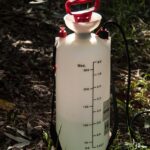
Sprayer to keep wasps and flies out of your home
- Keep shrubs from touching the side of your house and spray a boundary around your home. Keep your shrubs and other vegetation trimmed so it does not come in contact with your outer walls of your home. This will limit crawling bugs from getting in the walls. At the base of the walls spray a boundary spray. I use Taurus SC mixed into a garden sprayer, but you can use ready to spray kits like Ortho Home defense.Spray a 4″ to 6″ boundary on the base of the exterior wall all the way around the house and around each bottom level window. Give special attention to downspouts and any pipe or wire penetrations in the home envelope. Just be sure to follow the directions on the pesticide label.
- Trees are routes of bug entry too. Each year while I am on my roof cleaning the solar panels and scooping out the gutters, I use my bug boundary spray up there too. I spray the our edge of the roof deck by the gutters, and around any vents that come through the roof. I also spray the crown of my fireplace chimney and around the cap. This helps to keep wasps and flies out of your home, since they love to follow cooking smells down the chimney.
- Lets talk termites. If you live in an area with termites (like I do in SC) then you need to take them seriously. They can get inside of any house, and you wont even see their entry point since they are subterranean. Every 7 years I do a termite trench with Dominion 2L all the way around my home. Termite trenching is when you dig a 6″ trench line at the base of your outside wall you saturate the dirt with termiticide and put it back in the trench.
Termite trenching effectively creates a bug-killing moat around you home. If you are not so keen on that much shoveling, you can hire a company to do this for you. They often offer an insurance for their work called a termite bond. If you decide to DIY it, as always be sure to follow the directions on the label.
It is hard to keep wasps and flies out of your home, as well as ants, termites, cockroaches, spiders, etc… but it is worth the effort.
Maintaining a home is tough work, especially if you are a DIY kind of person. You can always hire a company to do this work for you, but it is worth the knowledge of knowing how to DIY it if you need to keep wasps and flies out of your home.
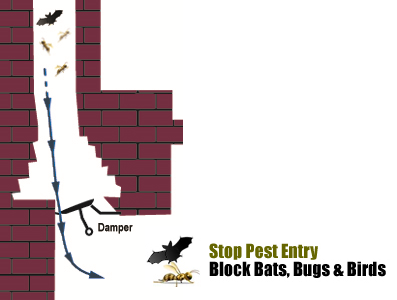
by blogediter | Jun 19, 2023 | Chimney Problems
How to stop bats and birds from entering your fireplace chimney
Have you ever spent your evening with all the doors and windows open as you try to coax a bat or bird out of your house? Then you know bats and birds are common pests that can find their way into your home through the fireplace chimney. Birds and bats eat mosquitos and are great to see flitting around your yard, but they are lousy house guests. So lets see how do I keep bats from coming down my chimney?
Bats can carry diseases, so there are dangers of bats in chimney, and you can’t safely smoke out bats in chimney. You may be wondering how to tell if bats in chimney. Bats in chimney sound like a quiet squeaky bike wheel, and they make a scuffling and scratchy noise as they climb. Bat removal from chimney cost stat at $120 for the service call and it usually cost another $100 for the relocation of the animal. So it is best to keep them from entering and claiming your chimney for their home.
Birds can make a mess and damage your chimney and home. Birds can make obnoxious noise and bring in flammable nesting material that plugs the chimney. Also their droppings smell very bad.
You cannot burn or smoke out birds either. But, if you have bats and birds in your chimney, there are a few things you can do to get rid of them and prevent them from coming back.
Listed below are 4 steps to stop bats and birds from entering your fireplace chimney:
1. Seal up any entry points. The first step is to seal up any entry points that bats or birds could use to get into your chimney. This includes any cracks or holes in the seam between where the brick chimney meets the homes wood or vinyl exterior. Inspect the crown and the flashing of the chimney and see if there are cracks they are getting through.
2. Install a chimney cap with a screen. Some chimneys have not cap at all, some have a cover with no screen, some have a screen with no cap. The best cap is one that is galvanized or stainless steel, and has a cover and a screen. A cap like this will last a long time, and prevents bats and birds from getting in, while still allowing smoke to escape. You can get a cheaper powder coated or painted sheet steel chimney cap, but they rust our fast and won’t last long.
3. Use a Flueblocker of Chimney Balloon. If you don’t want to mess with a cap at the roof, Don’t rely on just your metal damper to keep out bats or birds. They can get through a metal damper without even slowing down. Metal dampers are loose and warped, so a bird or bat can slip right past a damper. You will need a tight seal from a Chimney Balloon or wool Flueblocker to stop a bat or bird.
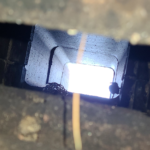
Bird in fireplace chimney flue
4. Call a professional. If you have a serious problem with bats or birds getting in repeatedly or nesting in your home, you may need to call a professional. A wildlife removal company will be able to safely and humanely remove the pests from your home, and troubleshoot the areas that may be letting them in. Sometimes the chimney is not the only location they gain entry.
Getting help stop bats and birds from entering your fireplace chimney
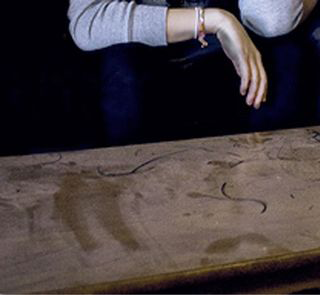
by blogediter | Jun 12, 2023 | Chimney Problems
Air sealing and air filter tips that can make your home a safe haven from wildfire smoke and dust
You can see on the wildfire smoke map more and more of the United States experience smoke from this season’s wildfires, it is important to air seal and air filter your home for fending off smoke and particulates. You can make your home a safe haven from wildfire smoke, so you can get away from the fine particulates from wildfires like PM2.5, that cause the greatest health concern.
Here are the 5 air sealing and air filter tips that can make your home a safe haven from wildfire smoke and dust. So you can see how to protect yourself from wildfire smoke:
1) Air sealing your home is essential. Modern homes operate under pressure. Sometimes homes are inhaling air from outside, and sometimes they are expelling air. HVAC, venting, clothes dryers, and all kinds of appliances affect how your home takes in outside air. Use a
Smoke Pencil to hunt around your house to see where your home is intaking air, and use weatherstipping, caulk, and foam to seal out air infiltration. If you notice a heavier than normal dust coating on your furniture, you can bet that the particulate count is up inside your home.
2) Focus on the biggest holes first. One of the worst culprits in letting in outside air is the dormant fireplace chimney. It acts like a snorkel sticking up into the smokey sky. Whenever you use an appliance that vents to the outside (like a clothes dryer), the negative pressure will pull outside air through the path of least resistance. That is often the chimney, even if it has a damper the metal is usually ill fitting and warped, allowing a gush of air to pass through. So use a tight fitting
Flueblocker or
Chimney Balloon to close the chimney off.
3) Air Filters are key: Eventually you need to open your doors to come in and out, so there is bound to be smoke that gets inside. It is hard to find the best
HEPA indoor air filters in stock at the moment, but there are
DIY home air filters that can be made with
furnace filters and a box fan that are very effective. Also have a close look at your HVAC filters in your A/C system. Do not use the cheap stringy fiberglass filters, rather make sure you have fine filters with a MERV rating of 13 or higher.
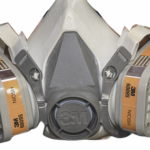
Protect against smoke with Respirator Mask
4) Mask shields up: When you do go out, it is best to have a P95 respirator mask with activated carbon. That way you are protected from particulates and chemicals that ride the smoke. They are only about $20 and they are well worth the price. You can even get some variety that cover your eyes as well.
5) Don’t make your indoor air quality worse: Avoid using your gas burning range while you are buttoned up avoiding wildfire smoke. Try heating food just with the microwave for a while. Limit using ventilation appliances like clothes dryers and vent fans. They create negative pressure in your home and force the house to take in more outside air. It may sound extreme, but hang a clothesline inside to dry your clothes.
It is also important to keep track of the public announcements of when you must evacuate an area due to poor air quality or even fire danger. Do not put you or your family and loved ones at risk. There are wildfire smoke health effects long-term and short-term.
In order to make your home a safe haven from wildfire smoke and dust, you should follow the steps above and contact us if you need help selecting products to air sealing your fireplace and home.
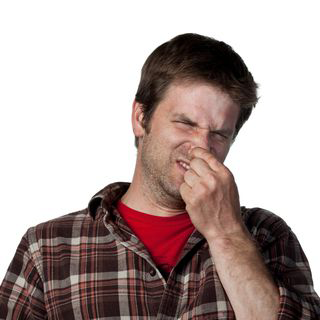
by blogediter | Jun 7, 2023 | Chimney Problems
Fix bad burnt smelly fireplace odors and foul smokey chimney ash stink
So you had a fire or two over the winter months, and even as it sits dormant your unused chimney smells bad. You made sure to clean out the old ash and leftover charred logs from your firebox, but the chimney smells when it rains. You even took out the vacuum hose and really cleaned out the firebox super well. But you are still trying to fix bad burnt smelly fireplace odors and the house smells like smoke from fireplace.
Most of the time, home owners go right to scheduling with their chimney sweep to stop the smell. But a chimney scrubbing can sometimes make the burnt smokey smell worse. Here are a few DIY cheap things to try first to help you stop the smokey chimney stink:
Here are the 3 steps to fix bad burnt smelly fireplace odors and foul smokey chimney ash stink:
1)
Seal the chimney low and tight. Your chimney operates like a dirty snorkel for your house. It breathes in and it breathes out. Even if your metal damper is closed, they do not seal tightly. Metal dampers warp when they are heated and cooled repeatedly. Also, the negative pressure in your house from clothes dryers, HVAC, vent fans, etc.. can suck outside air right down the flue and drag in chimney smells. By installing a
Flueblocker or
Chimney Balloon as low as possible in the flue, you can seal much of the smell outside.
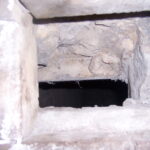
Ash pit causes smokey smell
2) Look for an ash pit. Look at the floor of your firebox. Is there a metal flapper there or an open hole that leads down into an ash dump pit? You may have to pry up and remove the flapper cover of the ash pit to get access to the hole itself. That chute will need to be sealed up tightly too. You can inflate a small Chimney Balloon into the pit to seal it off tightly.
3)
Baking Soda to deodorize the firebox. The firebox may be clean and vacuumed out, but the creosote glaze or leftover ash could still be releasing acrid acidic odors. This is how to make fireplace smell good and how to get rid of soot smell in house. Take a full box of
baking soda and sprinkle it over the floor of the firebox, and throw it against the walls of the firebox.
You can use a little spray bottle of water to damper the walls to get the powdery baking soda to stick, but don’t go too crazy with the sprayer. Let that sit in the firebox for a few weeks, and use a vacuum hose with a VERY good filter to vacuum that up.
99% of the time these 3 tips work and eliminate the odor issue, but If you still need to fix bad burnt smelly fireplace odors and foul smokey chimney ash stink contact us for personalized troubleshooting over the phone. You may have some chimney or home related issues to take into consideration.
There are a million variables, and we can help you get to the bottom of it, so you can close the burnt fireplace smell out of your home.










